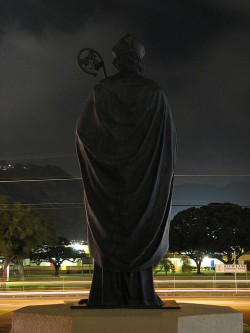Even saints have bad days.
So often saints are seen as larger-than-life figures that have somehow been endowed with perfection and the ability to be compassionate and loving under all circumstances.
One of the things I love about Irish folklore is that saints and religious figures are portrayed as human beings with the same flaws as the rest of us. This is as true of Jesus and his mother Mary, as it is of Christian saints and Celtic heroes and heroines.
Another thing that has always intrigued me about ancient Irish spirituality—and which is very evident in manuscripts from the early Celtic Christian Church (before power was centralized in Rome)—is the close connection between spirit and nature. They weren’t seen as separate, as became the case later, but as united in a symbiotic relationship.
The story below is one of many gathered from the dying circle of traditional storytellers and preserved within the Folklore Departments of Irish Universities. It’s a simple tale but it illustrates both of these aspects and may be a refreshing change from green beer and parades.
St. Patrick Curses the Irish
St. Patrick had a hard time converting the people of Ireland to Christianity. It wasn’t unusual for them to return to their former lives as pagans, abandoning the new religion.
One night, exhausted and angry from the effort, St. Patrick fell asleep. As he slept, he dreamed that all of those he’d managed to convert had deserted Christianity. He turned over in his sleep and muttered out loud, ‘God’s curse on the people of Ireland.’
A Guardian Angel heard him and said, ‘May it fall on the rushes.’
After a while, St. Patrick turned over again in his sleep and muttered, ‘God’s curse on the people of Ireland.’
No sooner had he uttered the words than the Angel said, ‘May it fall on the ferns.’
And yet a third time, St. Patrick turned over and muttered the same words, ‘God’s curse on the people of Ireland.’
And the Angel intervened again, saying, ‘May it fall on the foam of the rivers.’
Which is why in Ireland, from that day to this, the tops of the rushes are withered, the ferns are bent and there’s often a yellow tinge to the foam on the rivers.
(Irish language version below)
Mallacht Phádraig ar Mhuintir na hÉireann
(Click here if you want to hear an audio of me telling it in Irish)
Nuair a bhí Naomh Pádraig ag múineadh an chreidimh do mhuintir na h-Éireann, bhí obair an-chrua le déanamh aige.
Go mion minic d’iompaigh siad ar ais ina bPágánaigh agus thréig siad an creideamh.
Oíche amháin bhí Pádraig an-tuirseach agus thit sé ina chodladh.
Thosaigh sé ag brionglóidigh.
Chonaic sé muintir na h-Éireann ag tréigean an chreidimh.
D’iompaigh sé thart ina chodladh agus dúirt sé os ard “Mallacht Dé ar mhuintir na h-Éireann.”
Chuala a Aingeal Choimhdeachta é agus dúirt sé “Ar bharr na mbrobh go dtite sé.”
Tar éis tamaill, d’iompaigh Pádraig arís agus dúirt sé os ard “Mallacht Dé ar mhuintir na h-Éireann.”
Ní túisce ráite aige é ná dúirt a Aingeal Choimhdeachta “Ar bharr na raithní go dtite sé.”
Tar éis tamaillín d’iompaigh Pádraig thart arís agus dúirt sé “Mallacht Dé ar mhuintir na h-Éireann.”
Ní túisce ráite aige é ná dúirt a Aingeal Choimhdeachta “Ar chúr na habhann go dtite sé.”
Ón la sin go dtí an lá atá inniu ann, tá barr na mbrobh seargtha, barr na raithní lúbtha agus is minic dath buí ar chúr na habhann.
Love elephant and want to go steady?
Sign up for our (curated) daily and weekly newsletters!
Editor: Bryonie Wise
Photo: Flickr
(Irish text: Comhaltas.ie)
 Share on bsky
Share on bsky






Read 0 comments and reply